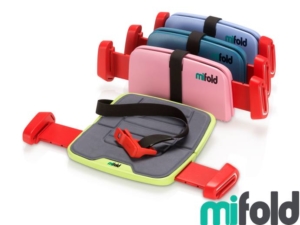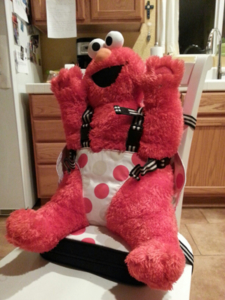Meet the mifold: a lighter, skinnier booster seat
 All of we traveling families have struggled with bulky car seats. Jon Sumroy recently devised an alternative: the mifold. This particular seat is designed to be so skinny and small that families can carry it everywhere—it actually fits inside your carry-on bags when you fly. In a few short months, the seat has generated quite a buzz—nearly $1 million in Kickstarter funding and a host of media coverage. I recently caught up with Sumroy to learn a little more about how the product came to market and what makes it unique.
All of we traveling families have struggled with bulky car seats. Jon Sumroy recently devised an alternative: the mifold. This particular seat is designed to be so skinny and small that families can carry it everywhere—it actually fits inside your carry-on bags when you fly. In a few short months, the seat has generated quite a buzz—nearly $1 million in Kickstarter funding and a host of media coverage. I recently caught up with Sumroy to learn a little more about how the product came to market and what makes it unique.
Q: Thanks for taking the time to chat with Wandering Pod. First, talk about the design of mifold itself. What inspired it? What was the challenge you were hoping to solve?
A: In 2001, when my wife and I lived in New Jersey, we were part of a carpool for the usual school run. Although we had booster seats for our own children, we did not have spares for the other kids we took to school. When the grandparents came to visit, we always had to transfer bulky boosters from one car to another. I thought, if I could make a booster seat that was very small and still safe, so a child could carry it all the time, my children could be safe no matter whose car they were in. My idea for mifold was to do the exact opposite of how a regular booster seat functions; instead of lifting up the child, mifold holds the seatbelt down. Holding the lap belt down to fit securely on the bones of the hips and pulling the chest strap down to fit securely on the bones of the shoulder. It was that simple. If a booster did not need to lift a child up, it did not need to be big and bulky. The idea of mifold was born, and it became a compact and portable booster seat that was so small, it could be carried by a child and stored almost anywhere.
Q: Child seats on airplanes is a huge issue for traveling parents. What makes you think people are going to buy-in to mifold?
A. We do not make mifold for use on airplanes; at this stage mifold is a car seat and is not tested or regulated for use on airplanes. Moving into the airplane market is part of our medium-term strategy, which we intend to pursue once we have established ourselves in the car market.
Q. What are the biggest benefits of this new tool? What do you perceive to be the biggest shortcomings/challenges?
A. The biggest benefits of mifold are that it has the potential to diminish the amount of children not properly restrained. Mifold eliminates those situations completely. Carpooling, car rentals, traveling, grandparents, taxis—these are all the normal life routine things we do, and they all will benefit from mifold. With a compact and portable device, a child can easily keep one with them all the time and drivers can easily keep spares, without cluttering up a car and losing cabin or luggage space. Children now can always be safe no matter whose car they are in. One of the biggest challenges that we are now going to be facing is educational. It is difficult for a person who has never seen mifold be able to understand that its function is to work as a regular backless booster seat. Our focus now is to create a great packaging design and increase our marketing so general awareness on the product can be created.
Q. What’s the age range? How old can kids who use the mifold actually be? How young can they be?
A. Mifold is designed for children between 4-12 years old. However, car seat regulations can be quite confusing and are different in each country; they can be based upon age, weight, height or a combination of all three. In the United States, mifold is designed for children weighing from 40-120 pounds; in the EU, for children weighing from 15 kilograms to the height of 135 centimeters.
Q. To what extent does the seat connect with the LATCH system in cars?
A. As with regular booster seats that simply rest on the vehicle seat, mifold uses the factory installed adult seat belts to restrain the child. All booster seats including mifold are designed to work without a latch system. There is no installation required with mifold, it is designed for ‘quick-in-quick-out’ usage for every journey in every type of vehicle.
Q. Beyond air and car travel, what are some other uses for this product?
A. As I’ve mentioned, carpooling is one of things that will benefit from mifold. Parents usually have boosters for their own kids, but not for the extra [kids who] come along. mifold is so small, kids can keep one in the school bag. It’s also great for taxi rides in big cities—very few of those have booster seats for kids. Mifold is so compact you can store on almost anywhere: glove compartment, door pocket, seat back, etc.
As of press time, the mifold retailed for $72. Unfortunately, the units are not available for purchase yet, so all orders are still considered pre-orders. Check it out!


